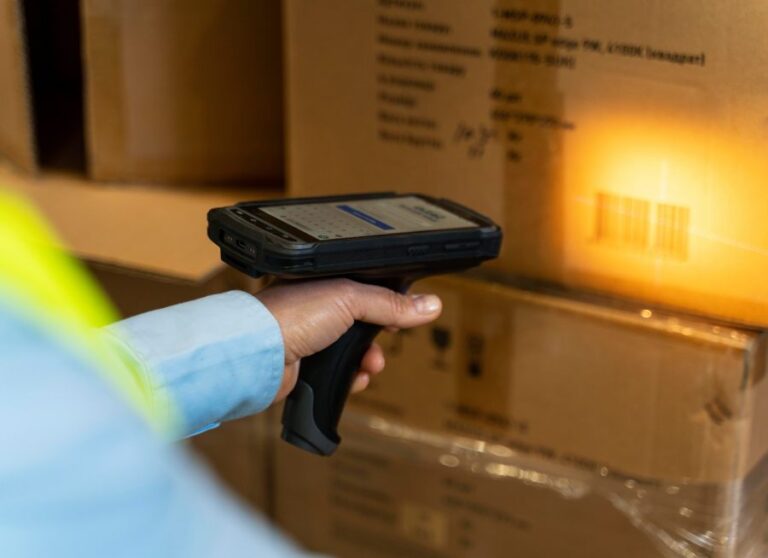Table of contents
Table of contents- What is the Digital Product Passport?
- What is the Digital Product Passport?
- EU objectives and regulatory framework
- What information does a Digital Product Passport contain?
- Priority sectors and implementation timetable
- Impact on supply chain management
- Challenges of implementing the Digital Product Passport
- How to prepare: recommendations for businesses
- Conclusion
One of the most common criticisms levelled against the European Union (EU) is its excessively bureaucratic structure and excessive zeal when it comes to regulation. Without going into whether these “accusations” are justified, the fact is that, in the medium term, a new regulation will come into force: the Digital Product Passport (DPP).
With this measure, the EU seeks to promote transparency and sustainability in supply chains, providing both businesses and consumers with access to detailed information about different aspects of products, mainly in terms of their environmental impact.
What is the Digital Product Passport?
Essentially, a product’s digital passport is a “digital identity card” that accompanies every product, component or material marketed in the EU. Using a data carrier such as a QR code, barcode or electronic tag, this system stores data on the product’s origin, its materials and manufacturing processes, its use and maintenance, and how to manage its end of life (repair, recycling or disposal).
Normally, the DPP information is available by scanning the identifier (e.g. with a smartphone), allowing the item’s history and properties to be consulted.
EU objectives and regulatory framework
The Digital Product Passport was created in the context of the European Green Deal and the EU’s circular economy strategy, which aim to achieve climate neutrality by 2050. The relevant legislation – Regulation (EU) 2024/1781 on the eco-design of sustainable products (ESPR) – stipulates that a digital passport will be mandatory for most products marketed in the EU.
What information does a Digital Product Passport contain?
The exact content of the Digital Product Passport will depend on the category of the item, as the specific relevant data will vary depending on the sector (for example, batteries must report their chemical composition and recyclability, while clothing must detail the fabrics and production processes). However, the EU has established minimum information requirements that virtually all DPPs must include. In general terms, a Digital Product Passport will contain:
1. Product identification and origin
A unique identifier (product code, GTIN, etc.) associated with the digital passport, together with the manufacturer’s or importer’s details, and the date and place of manufacture. This ensures that each item can be unambiguously linked to its corresponding ‘digital file’. In the current context, where restrictions on purchasing products from certain countries are commonplace, this could be particularly relevant.
2. Composition and materials
Details on the composition of the product, including the list of materials, components and their proportions, the origin of the raw materials used, the presence of restricted hazardous substances and the percentage of recycled content it incorporates. This information is crucial for assessing the sustainability of the product.
3. Environmental footprint
Indicators of environmental performance, such as the product’s carbon footprint (emissions generated during its manufacture and life cycle), its energy efficiency, water consumption in production, and even environmental product declarations or similar.
4. Durability and repairability
Information on the expected useful life of the product, its resistance and durability, and details to facilitate its maintenance. For example, it will include instructions for proper use, repair and care guides, availability of spare parts, and disassembly manuals for repair. All of this aims to prolong the life of the product and prevent premature obsolescence.
5. End of useful life and recycling
Guidance for the user or waste manager on how to properly dispose of or recycle the product when it is no longer usable. This includes recycling instructions, possibilities for reuse or reconditioning, and information on the recovery of valuable materials contained in the item. This section seeks to close the loop by ensuring that products do not end up in landfills but instead return to the production chain.
6. Regulatory compliance and certifications
Data demonstrating that the product complies with all regulations and standards. For example, references to safety or sustainability certifications obtained, results of mandatory tests, and compliance with specific EU requirements for that type of product, etc. This allows authorities and consumers to instantly verify the legal compliance of the product and its credentials.
Priority sectors and implementation timetable
Given the ambition of this regulation, the implementation of the DPP will be gradual. The EU has defined priorities by sector based on the environmental impact and circularity potential of each industry. The first sectors to be covered will be those with the largest ecological footprint or volume of waste, such as batteries, electronic equipment, textiles and footwear.
The current timetable is as follows:
- The Ecodesign Regulation, which is the European regulation introducing the Digital Product Passport, came into force in July 2024, paving the way for the development of product-specific standards during 2025-2026.
- In February 2027, the digital passport requirement will come into force for industrial, automotive and portable batteries placed on the market.
- Throughout 2027, the first wave of mandatory DPPs is expected for sectors such as textiles/fashion, consumer electronics, tyres, detergents, etc., as the corresponding delegated acts are approved.
- Subsequently, between 2028 and 2030, the passport requirement will be extended to more sectors, possibly including industries such as packaging and plastics, chemicals, machinery, furniture, mattresses and other consumer goods.
Impact on supply chain management
In practical terms, the Digital Product Passport should impact supply chain management by making information about each stage and component of the product more accessible. For example, if a defect arises in a certain batch of products, the digital passport would allow the source of the problem (a specific material, a particular supplier, a manufacturing process) to be quickly located and recalls or corrections to be expedited.
Similarly, a manufacturer could instantly verify the certifications and sustainable origin of the raw materials provided by its suppliers, facilitating transparency throughout the process.
The desired outcome is a more transparent supply chain in which all actors can access unified and verifiable product information.
Challenges of implementing the Digital Product Passport
Due to its ambition and scope, the implementation of the DPP will entail significant challenges.
Increased workload
Collecting and updating data will place an extra workload on companies, with a particularly high impact on smaller ones. To comply with the regulations, companies will need to invest in technology and adapt their internal information management processes. It will also require establishing procedures to collect information from multiple sources throughout the chain (raw material suppliers, component manufacturers, etc.), which can be complex if a company is not digitised.
Data interoperability
Another challenge is ensuring data interoperability and quality. For the DPP to work across sectors, information must follow common standards and be correctly interpreted by any system.
Divergence between passports from different sectors
If different sectors develop passports with very different requirements, suppliers of raw materials or components that serve multiple industries could face an overload of work in having to comply with multiple formats. It is therefore important to move towards unified, open and machine-readable formats to avoid fragmentation that would be detrimental to the main objective. The protection of confidential data is also another concern.
International context
Many of the key players on the global stage are committed to moving towards global sustainability goals at a much slower pace – for example, the already-approved regulation to ban the sale of combustion engine cars by 2035 in the EU is widely questioned – while the leaders of some states directly dispute the veracity of climate change. In this context, initiatives that seek environmental responsibility through mandatory legislation may face greater difficulties in gaining acceptance.
How to prepare: recommendations for businesses
This new regulation poses a challenge for the private sector, especially for smaller companies that do not have a well-developed compliance department. Here are some general recommendations for successfully implementing the digital product passport project.
Assess and digitise available data
Take stock of the product information you already have (technical data sheets, compositions, certificates, carbon footprint data, etc.) and identify any information gaps that need to be filled. It is essential to start digitising any relevant data that is only available on paper or in unconnected systems so that the information can be integrated into the DPP in a structured electronic format.
Implement a PIM system or other data management tools
A Product Information Management (PIM), or other similar platform, can centralise all information, ensuring that it is up to date and consistent. These tools make it easy to automatically populate the digital passport fields and update changes (e.g. if a supplier or composition changes).
Collaborate with suppliers and supply chain partners
Full traceability can only be achieved if all links in the chain contribute their share of data. It is advisable to communicate with key suppliers to inform them of future requirements and coordinate how they will exchange the necessary information. Establishing data-sharing agreements or integrating systems with suppliers can ensure that, when the time comes, the details of the origin, materials and certifications of each component are available.
Invest in identification and data capture technologies
Prepare to label products with QR codes, RFID tags or other technologies that link to the DPP. Also, evaluate the use of sensors or tracking systems that automate the collection of certain data (e.g., energy consumption meters in manufacturing for carbon footprint). Early adoption of these enabling technologies will make the transition smoother.
Adopt data and interoperability standards
Align with international standards for encoding and sharing information (e.g., ISO standards). This will ensure that the product passport is compatible with customer and government systems. Involvement in sector-specific initiatives or DPP pilots can also help identify sector-specific best practices.
Appoint responsible parties and plan internally
Assign a DPP team or manager within the company to lead these efforts. This team should define an action plan with clear objectives, KPIs and deadlines, aligned with EU deadlines. Preparation may include internal training on the DPP, pilot testing on some products, and integrating the new data collection into everyday processes (e.g., incorporating digital passport completion into the product development cycle).
Following these guidelines will enable companies to transition more smoothly to the new model. In addition, preparing in advance provides an opportunity to refine processes and systems with sufficient time and obtain feedback from the relevant authorities before compliance becomes mandatory.
Conclusion
A decade ago, 96 countries signed the Paris agreements. It was a truly global agreement to advance the fight against climate change. Today, the zeitgeist (spirit of the times) is completely different, and not many states are willing to take high-impact environmental measures if it means sacrificing part of their economic development.
If the European Digital Passport were to be voted on today in the European Parliament – with the current composition of political groups – it would be very difficult for it to pass. However, the fact is that the law has already been approved and what remains is to roll it out and implement it. We will see if, in the current context, there is sufficient political will to do so and if the deadlines set out on paper are met.







